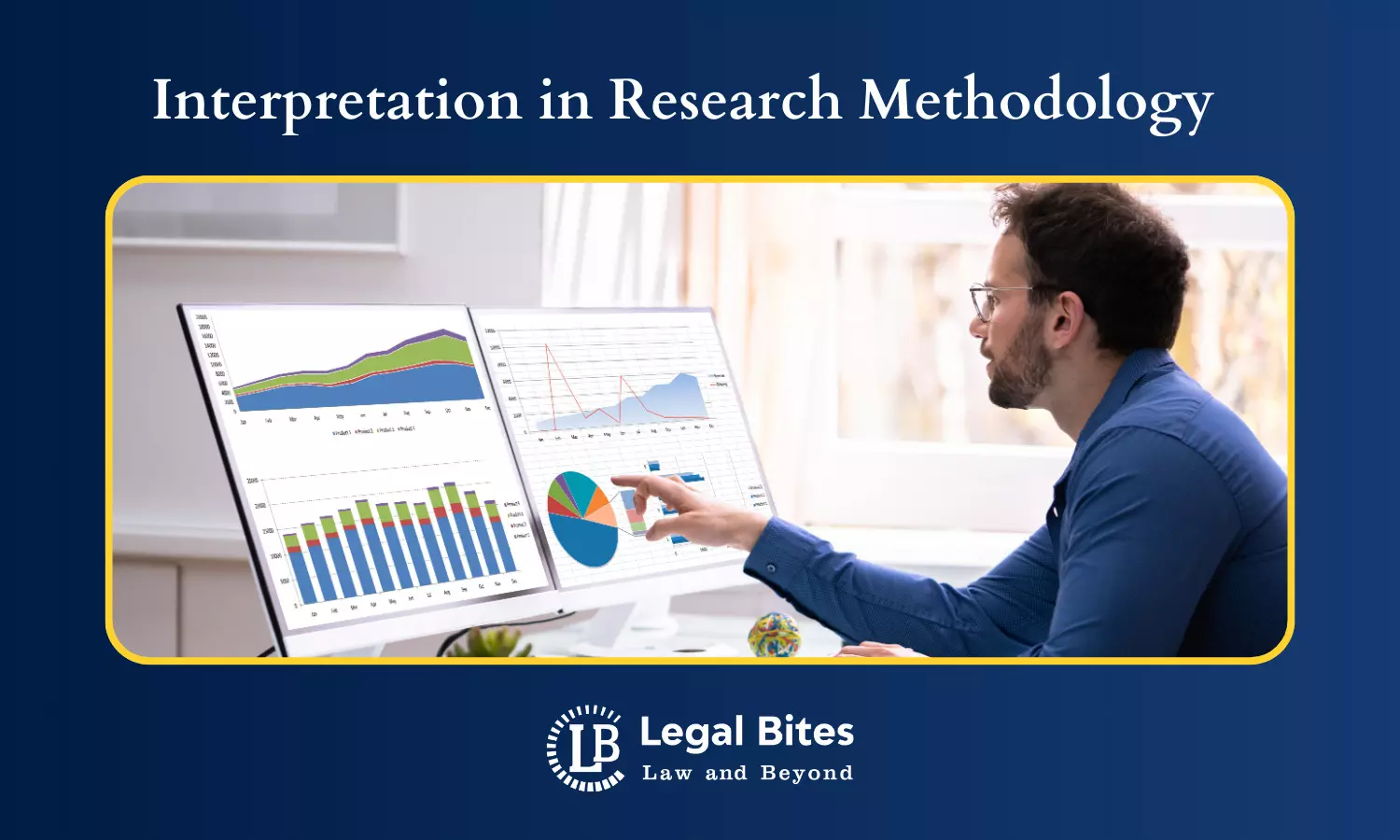Interpretation in Research Methodology
Interpretation involves analyzing and explaining data to uncover insights and draw conclusions that address the research question.

Research Methodology includes a wide variety of research techniques and tools, which can be further utilized to collect, analyse and interpret the collected data to form the conclusion of any research. Amongst others, ‘Interpretation’ is a crucial aspect of the research which ensures that the data collected during the research is duly utilized for drawing meaningful conclusions. Therefore, discussing the utility of interpretation in research and its methods, challenges, and best practices is pertinent.
Introduction
Interpretation can be broadly understood as the process of converting collected data into meaningful conclusions by drawing inferences, identifying patterns, and making connections between different aspects of information gathered during the research to generate meaningful results. Interpretation is considered a very crucial aspect of research methodology, as without interpretation, the raw data cannot result in much valuable knowledge which can eventually result in informed decision-making, policy formulation, and further research.
Significance of Interpretation
Interpretation holds significant value in the research methodology for various reasons such as:
- Research Data Transformation: No matter how extensively any research data has been gathered, it holds lesser value till the time the researcher interprets the data following the research design. The process of interpretation ensures context in any research and allows the researchers to contemplate what the research data truly signifies.
- Verifying Hypothesis: Through the process of interpretation, the researchers eventually confirm or refute the hypothesis of their research, thereby leading to a deeper understanding of the research area.
- Informed Decision Making: In fields like medicine, business, and public policy, well-interpreted data is crucial for making informed decisions that can have significant real-world impacts.
- Identifying Trends and Patterns: Through Interpretation, the Researcher can identify the trends/patterns, which cannot be recognised merely by raw data.
- Evidencing Existing Theories: By way of Interpretation, a researcher often provides empirical evidence, which eventually supports or opposes the pre-existing theories and principles.
Methods of Interpretation
The Interpretation of the raw data, which is gathered from preliminary research can be of various types, which mainly depends upon the nature of the study, the type of data collected, and the research objectives. Interpretation can be broadly classified into ‘Qualitative’ data interpretation and ‘Quantitative’ date interpretation as under:
a. Qualitative Data Interpretation
Qualitative data interpretation is a method of interpretation wherein the phenomena, behaviours, and patterns are identified and analysed by way of non-numerical data. It majorly focuses on analysing the meanings, patterns, and themes of the gathered data to gain deeper insights into the same. Qualitative data interpretation can be of various types such as:
- Thematic Analysis Method: This interpretation method includes the identification of themes or patterns within the qualitative data. In this method, the researchers code the data and then analyse such codes to identify overarching themes.
- Content Analysis Method: This method majorly involves checking the frequency of specific words or phrases within qualitative data, thereby analysing the presence of such words or phrases.
- Narrative Analysis Method: This interpretation method majorly focuses on the stories and personal accounts which are present within the raw data. Such narratives are then analysed by the Researchers to verify theories and findings.
- Grounded Theory Method: This interpretation method involves curating new theories based on the analysis of raw data itself, instead of verifying the existing theories and principles. The Researchers often collect and analyse the data simultaneously, thereby allowing new theories to emerge organically.
b. Quantitative Data Interpretation
Quantitative data interpretation, on the other hand, is an interpretation method wherein the statistical, mathematical, or computational techniques are collectively utilized for understanding, and analysing the behaviour, phenomena, or events. This interpretation method is only concerned with quantifying relationships, patterns, and trends through numerical data. Quantitative data interpretation can be of various types such as:
- Statistical Analysis Method: This method is one of the most common methods in quantitative data interpretation, and majorly involves the statistical tools and techniques for the analysis of numerical data, testing hypotheses, and drawing conclusions based on the same.
- Descriptive Statistics Method: This interpretation method provides a comprehensive summary of the data by utilizing measures of central tendency i.e., mean, median, mode etc. and measures of variability such as range, variance, standard deviation etc.
- Inferential Statistics: This method involves curating inferences concerning any population by way of sampling. Some of the common techniques of inferential statistics include regression analysis, correlation, t-tests, and chi-square tests.
- Data Visualization: This method involves the interpretation of the research data by way of graphs, charts, and other visual tools. This method eventually provides a summary of voluminous data and turns it into an easily recognizable interpretation by making patterns and trends.
c. Mixed Methods
In mixed methods of interpretation, both qualitative and quantitative data are collected by the researchers and are interpreted together, thereby providing a robust and comprehensive research finding. This integrated approach eventually provides a more detailed understanding of the research problem and leads the researcher to a holistic conclusion.
Challenges in Interpretation
While interpretation is considered one of the most important aspects of research, it is also fraught with various challenges, despite being important. Some of the crucial challenges to the interpretation method are as follows:
- Personal Bias: When the researcher's personal belief influences the choice of research question and methodology, it eventually leads to skewed or inaccurate conclusions. This is one of the major challenges of fair interpretation in the research process.
- Data Complexity: When the collected datasets are voluminous and complex, it poses challenges to accurate interpretation, thereby requiring advanced analytical skills and tools.
- Ambiguous Data: The collected data can sometimes lead to multiple interpretations. Such data can pose grave difficulty in accurate interpretation as it prevents definitive conclusions.
- Contextual Factors: The researcher should keep in mind the context in which the data has been gathered. If the context is ignored during the interpretation, it may lead to erroneous conclusions.
- Reliability and Validity: The researcher should ensure that the data collected is valid and reliable, to ensure reliability and validity of the data is crucial for accurate interpretation. Any flaws in data collection can compromise the interpretation process.
Best Practices in Interpretation
To ensure accurate interpretation and address the abovementioned challenges, there are a few practices which the researcher may adopt:
a. Triangulation
Triangulation is the method of verifying the interpretation through multiple sources to cross-check the findings, thereby enhancing the overall credibility of the interpretation. This method helps in validating the research findings through multiple perspectives.
b. Peer Review
The quality and credibility of interpretation can also be enhanced by engaging peers and research experts, who can review the interpretation process and add their inputs wherever required. Such feedback and input from peers help in identifying and mitigating errors. This adds a layer of review and increases the credibility of the interpretation.
c. Research Reflexivity
During the interpretation process, the researchers should ensure that they reflect their own biases, assumptions, and potential influence on the work which they are undertaking. Such reflexivity includes being aware of the research objective and striving for such objectivity.
d. Clear Documentation
The researchers should ensure that the details of the interpretation process are duly recorded, which includes the coding schemes, decision rules, analytical steps etc. This enhances the transparency of the research, as it allows others to verify the process and cross-check the findings.
e. Contextualization
The researchers should keep in mind every aspect of gathered data including but not limited to the social, cultural, historical and environmental factors to interpret the data in the same context, in which it was collected, to avoid any external influence.
f. Use of Software Tools
To avoid any possible human errors, the researcher may consider using the research tools which assist the researcher in data analysis and interpretation for the research. While the interpretation of quantitative data can be done through software like SPSS etc. the qualitative data can be interpreted through the NVivo, Atlas. ti etc. Such tools not only facilitate accurate and efficient data interpretation, but it is also time-efficient.
Conclusion
Interpretation is a vital component of the research process, which duly ensures that raw data gathered by the researcher is transformed into a meaningful result. However, the researcher must ensure that the interpretation is undertaken carefully and systematically to ensure maximum credibility, accuracy and reliability. If the researchers are careful and duly follow the best practices keeping in mind the inherent challenges of the interpretation, they may end up drawing meaningful conclusions thereby leading to knowledge advancement.
Whether the raw data gathered is qualitative, quantitative, or mixed methods, the ultimate objective of the researcher while interpreting the same should be to uncover the underlying truths and patterns of such data, thereby leading to an in-depth research broader understanding of the research problem.
References
[1] Jerry Schoen, Data Interpretation, Available Here
[2] Dilip Kumar Kulkarni, Interpretation and display of research results, Available Here
[3] Malarvizhi. V, Interpretation: Research Methodology and Statistics For Home Science, Available Here
[4] Jessica Abbadia, Understanding the Interpretation of Results in Research, Available Here
[5] Wolfram Miekisch, Data interpretation in breath biomarker research: pitfalls and directions, Available Here

